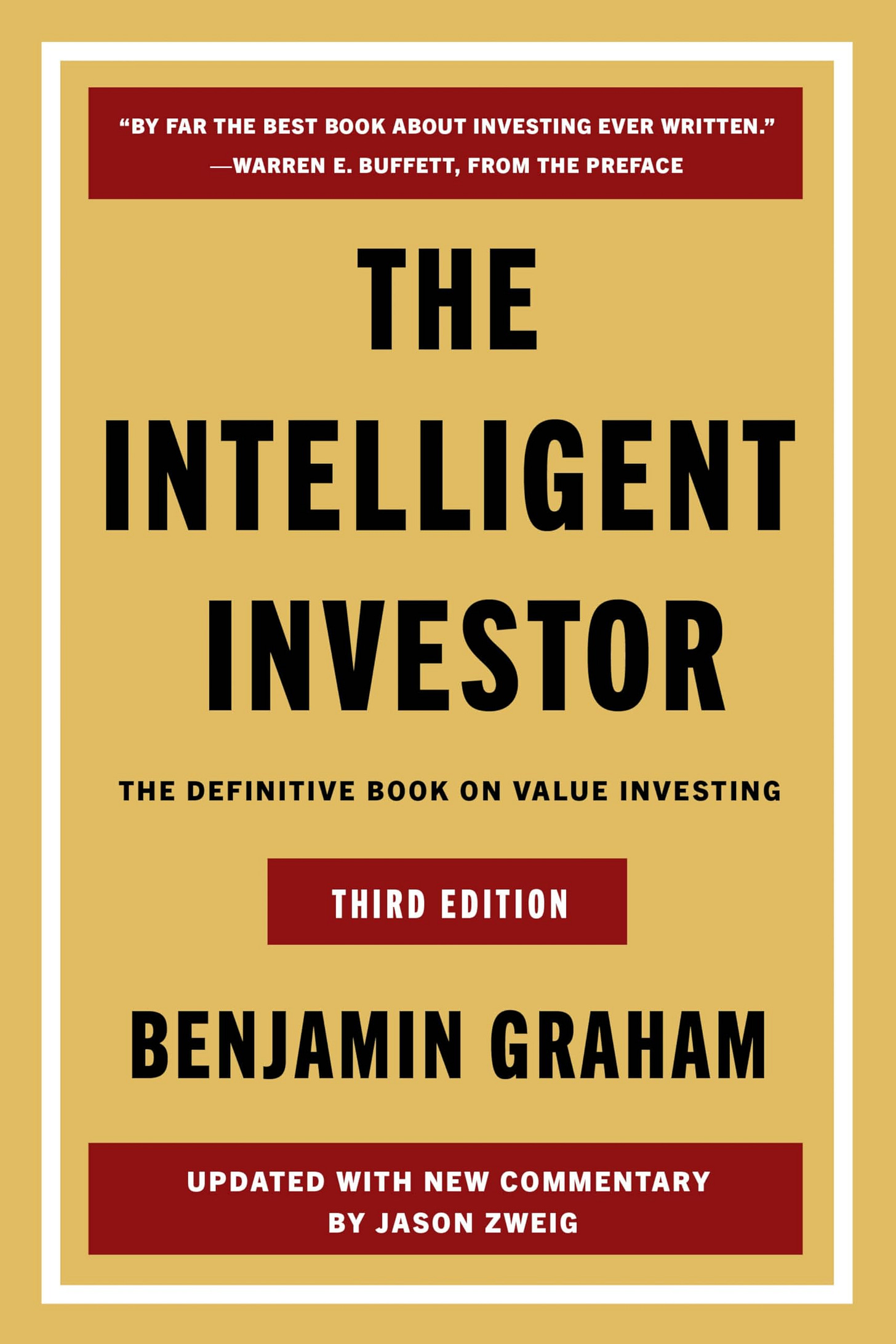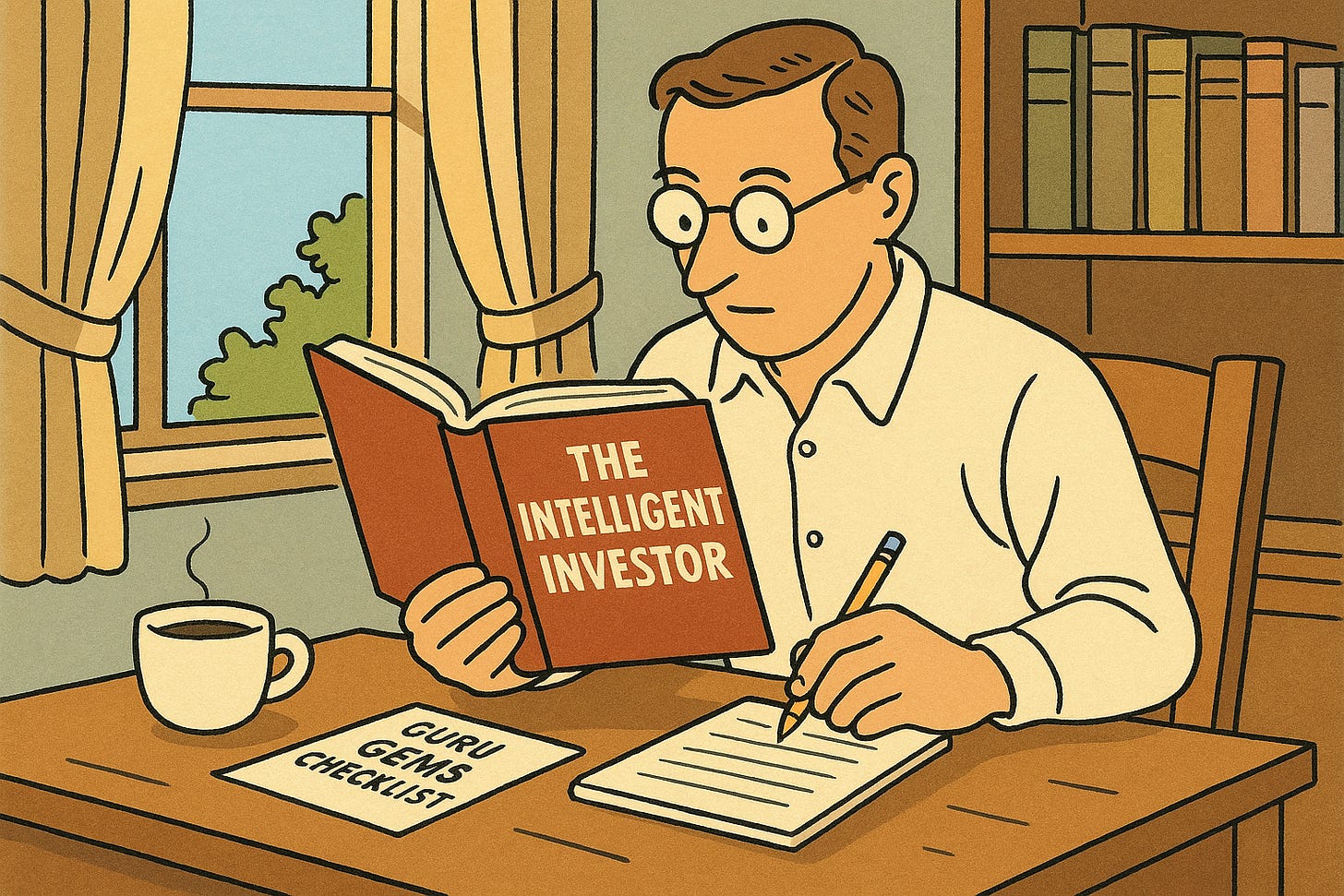The Intelligent Investor (Reloaded) — And the Checklist Every DIY Investor Needs
Revisiting the 'Classic of all Classics' with Jason Zweig
Welcome back to Guru Gems for your weekly dose of timeless investment wisdom from the world’s investing masters.
New to Guru Gems? Start here.
If you would walk into the office of almost any great investor—from Joel Greenblatt to Howard Marks—you would likely find a worn-out copy of one specific book on their shelf:
The Intelligent Investor by Benjamin Graham
Warren Buffett, who was a student of Graham at Columbia Business School, calls it “By far the best book about investing ever written.”
“If you follow the behavioral and business principles that Graham advocates - and if you pay special attention to the invaluable advice in Chapters 8 and 20 - you will not get a poor result from your investments.”
—Warren Buffett in the Preface to the Revised Edition of The Intelligent Investor
Buffett has repeatedly praised Graham’s book - here is a great short clip from the 2008 Berkshire Hathaway Annual meeting where he shares the three big lessons from the book on one’s attitude towards stocks:
Anyone who has read the book (which was first published in 1949), will agree that the language can be quite ‘dry’, and the examples (like railroad bonds) can feel ancient.
That’s why, for this week’s deep dive, I am going to dig into the Revised Edition from 2024, featuring new commentary by financial journalist Jason Zweig.
Zweig’s commentary is brilliant and he manages to connect Graham’s timeless principles to the modern world of AI stocks, crypto, and 24/7 news cycles.
Zweig was interviewed by William Green on my favorite podcast when this third edition came out - I highly recommend watching this interview:
This will be my 3rd review of an investing ‘Classic’:
Peter Lynch’s One up on Wall Street taught us to “invest in what you know”
Howard Marks’ The Most Important Thing taught us how to survive the investing journey
Ben Graham’s Intelligent investor lays down the guidelines and principles that are the foundation for investing success
Let me know what you think in the comments and which other investing classic I should cover in a future edition.
Please click the 🤍 at the top or bottom of this post if you enjoy this article, it would mean a lot and will also help the algorithm ;)
You can also follow me on X @guru_gems for more Guru Gems insights.
Ben Graham’s 4 core principles
In the introduction of the book, Jason Zweig talks about Ben Graham’s 4 core principles that are timeless and that can help you to invest intelligently:
Stocks represent an ownership interest in a business, they are not just pieces of paper or a ticker symbol. The intelligent investor studies the business, not the stock.
You can’t be an investor without trading, but you can trade without ever investing. The intelligent investor does thorough research into establishing the value of a business; a speculator is betting on what other people are going to do, typically in the short term.
Most of the time markets are right, but they can be terribly wrong at times. Graham introduced the metaphor of a character called ‘Mr. Market’ who goes wild with euphoria when stocks go up but is extremely fearful when stocks go down.
Most investors focus too often on how much money they could make if they turn out to be right - but forget to consider how much they could lose if they turn out to be wrong. The intelligent investor always maintains what Graham called a ‘margin of safety’.
Now let’s follow Warren Buffett’s advice and “pay special attention to the invaluable advice in Chapters 8 and 20” which cover principles #3 and #4
The Manic-Depressive Business Partner
Ben Graham’s Intelligent Investor is perhaps most known for introducing a very famous metaphor in finance: Mr. Market.
Graham asks you to imagine you own a business in partnership with someone named Mr. Market. Every day, he tells you what he thinks your interest is worth and offers to either buy you out or sell you an additional interest.
Some days, he sees only sunshine and names a very high price.
Other days, he is terrified of the future and names a very low price.
Graham’s Lesson: The market is there to serve you, not to instruct you. Price fluctuations have only one significant meaning for the true investor: they provide an opportunity to buy wisely when prices fall sharply and to sell wisely when they advance a great deal.
Zweig’s Update: Zweig points out that in the modern era, Mr. Market is on steroids. With trading apps, social media, and notifications on our phones, Mr. Market is knocking on our door 10,000 times a day.
Zweig argues that “individual investors actually have a structural advantage over professionals”, as you are not forced to sell when your peers are selling or when clients are redeeming money - your biggest edge is emotional discipline.
He reminds us of the craziness of the “meme stocks” in 2020 and 2021, where “millions of novice traders stampeded into GameStop, AMC and Virgin Galactic Holdings, regardless of the health of the underlying business.”
Here is Warren Buffett again, now during the 2012 Annual Meeting, talking about how Mr. Market sometimes behaves like a ‘Psychotic Drunk’:
“Margin of Safety” as the Central Concept of Investment
If ‘Mr. Market’ teaches us something about emotional discipline, ‘Margin of Safety’ teaches us something about analytical discipline.
A bridge required to bear a load of 40 tons is built to hold 70 or 80 tons. The extra capacity is the margin of safety.
Graham introduced the concept of margin of safety as the buffer between what you pay and what a business is truly worth.
Graham’s Lesson: The margin of safety is always dependent on the price paid. The wider the gap, the more room you have to be wrong about your analysis while still making money.
If you think a company is worth $100, you don’t buy it at $95. You buy it at $60. That gap is your Margin of Safety. It protects you from:
Bad luck;
Bad calculations;
Unforeseen events.
Zweig’s Update: In the modern era, he argues, the margin of safety is not just numerical — it’s also psychological:
A margin of safety in how much you save;
A margin of safety in how much you trade;
A margin of safety in your expectations;
A margin of safety in your behavior.
Zweig’s commentary is filled with painful stories of investors who understood valuation formulas but ignored their own limitations.
Let’s hear again from Buffett, this time during the 1997 Annual Meeting, talking about margin of safety and learning from your mistakes:
☑️A Practical Tool: The Intelligent Investor Checklist
I would like to finish this week’s newsletter with something I hope will be a very practical tool for DIY investors.
Multiple times in the book, Jason Zweig suggests that intelligent investors should create and follow a checklist.
“By imposing a rule on yourself - I will never buy a stock without first completing a checklist - you can avoid the heartache that comes from selling in a panic after buying on an impulse.
[…] It compels you to be consistent and ensures that you don’t underemphasize or overlook factors you intend to rely on. Above all, it enables you to learn what works, what doesn’t, and how to improve your analyses.”
I really like this idea of a checklist and I have created a one-page “Intelligent Investor Checklist” inspired by the wisdom of Graham and Zweig, and also including elements from some of the Gurus studied so far.
As a subscriber of Guru Gems, you can get your copy of the Intelligent Investor Checklist for free! 👇
This checklist is not exhaustive, but I do think it is a good start to help DIY investors become more disciplined, and more importantly, stay disciplined and consistent when markets go crazy.
As Graham wrote in the first edition of his book:
“The investor cannot enter the arena of the stock market with any real hope of success unless he is armed with mental weapons that distinguish him in kind - not in a fancied superior degree - from the trading public.”
I hope you enjoyed this week’s Guru Gems newsletter. I will be back next week with a new edition!



